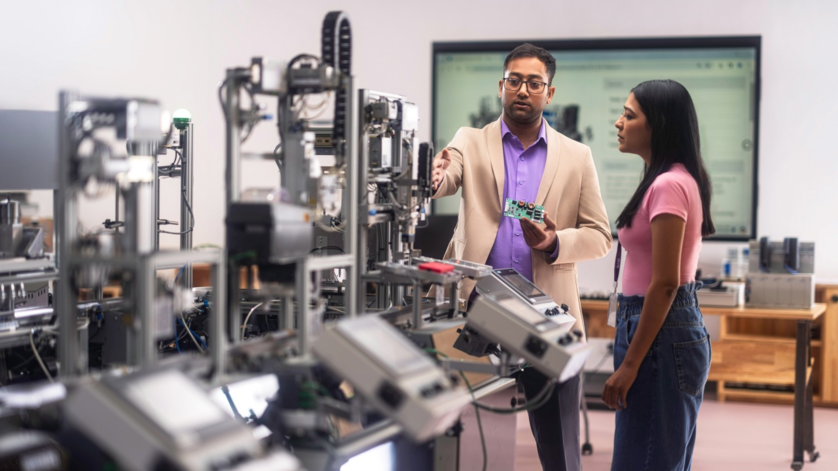India’s Semiconductor Revolution Set to Create 1 Million Jobs by 2026 | – Times of India
India has embarked upon an ambitious journey in the semiconductor sector, which is expected to generate about 1 million new jobs1 by 2026. The Viksit Bharat initiative by the Government of India and the emergence of Gujarat as a semiconductor hub are together increasing the demand for a workforce that is trained and experienced in the nuances of this sunrise sector in the country. A March 2025 report by Jefferies, one of the leading full-service investment banking and capital markets firms in the world, has highlighted that the strength of India lies in chip design since it is already home to almost 20 percent2 of the global semiconductor design workforce. However, there is a significant skill gap in the areas of semiconductor fabrication (fab) and testing. A 2024 report by TeamLease Degree Apprenticeship reinforces this concern, warning of a significant skills gap in India’s semiconductor sector. It projects a shortage of 250,000 to 300,000 professionals3 by 2027. This reality is highlighted by media reports stating that major manufacturers such as Tata Electronics are sending hundreds of employees to Taiwan for specialized training. These facts underline the urgent need in India for skilled professionals who can fill this gap with adequate knowledge and training in a sector that holds immense promise for growth and success. To address this demand, NAMTECH (New Age Makers’ Institute of Technology) is offering comprehensive courses under its International Professional Master’s Programs (iPMPs), with courses such as smart manufacturing & AI, semiconductor manufacturing, advanced robotics technology and sustainability engineering. This global, pioneering institute by ArcelorMittal Nippon Steel (AM/NS) India in Gandhinagar, Gujarat, is built specifically to address the gap between conventional engineering education in India and future industry requirements.Graduates from India’s best engineering colleges can enrol for NAMTECH’s iPMP, which is an accelerated, 1-year, fully residential course that provides superior education and training in courses that are co-designed and co-delivered with industry players and global academic institutes. NAMTECH’s partnership with international institutes of repute such as Technical University of Munich (TUM) Germany Asia Campus and Purdue University Northwest, USA, ensures that select students can also benefit from global immersion opportunities at these institutions.

.
NAMTECH pedagogy focuses on real-world experiences and training, and hence the syllabus is designed to provide students with micro-factories, digital labs, and industry-grade systems. The institute’s debut batch achieved 100 percent placements, underscoring how well its curriculum aligns with industry expectations.NAMTECH is making this opportunity of gaining world-class education and real-world experiences more accessible to meritorious students in India by inviting applications for 100 fully funded fellowships for engineering graduates from IITs, NITs, IIITs, BITS, and other top institutions. NAMTECH benefits from being in the heart of India’s semiconductor industry NAMTECH’s global partnerships will enable students to gain international experience without the associated costs and uncertainties of enrolling in foreign institutes, while the institute’s state-of-the-art campus in Gandhinagar means it is in the heart of India’s semiconductor revolution.
Gujarat has emerged as the hub of the industry, with some of the biggest companies setting up their facilities there. These include Tata Electronics & PSMC Fab in Dholera, Micron Technology ATMP in Sanand, , CG Power, Renesas, and Stars Microelectronics JV and Simmtech. The Dholera facility of Tata Electronics alone is expected to give rise to more than 20,000 skilled positions. According to the Ministry of Electronics and Information Technology (MeitY)4, only 6,000 graduates every year are equipped to contribute to fab operations without further specialised training. This highlights the advantage of an institute such as NAMTECH, which is producing industry-ready engineers, who are equipped with the skills and knowledge of this specialised sector.

.
The Government of India has approved the ‘Modified Programme for Semiconductors and Display Fab Ecosystem5, and has allocated an outlay of Rs76,000 crore for the semiconductor and display ecosystem. Up to 2.5 per cent of this budget is earmarked for R&D, skill development and training requirements. In addition to this, the government has set aside Rs1,000 crore for the Design Linked Incentive Scheme to support the fabless chip design industry, including semiconductor R&D activities.References – Disclaimer – The above content is non-editorial, and TIL hereby disclaims any and all warranties, expressed or implied, relating to it, and does not guarantee, vouch for or necessarily endorse any of the content.





